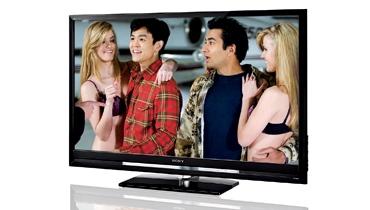Sony Bravia KDL-46Z4100 46-inch LCD HDTV

| The Short Form |
| $2,300 ($2,800 list) / SONYSTYLE.COM / 877-865-7669 |
| Snapshot |
| Sony's slim new Z-series LCD looks great and, a few picture quirks aside, offers solid video performance as well |
| Plus |
| • Balanced, natural-looking color • Sleek, appealing design • Excellent screen uniformity and viewing angle for an LCD • Plentiful inputs and picture adjustments |
| Minus |
| • Slightly fluctuating black level on dark scenes • Odd, occasional red "ghosting" effect |
| Key Features |
| • 120-Hz display • TV Guide On Screen Program Guide • HDMI 1.3 connections • DLNA-compliant • 1080p/24 input-capable with 5:5 pulldown • Inputs 4 HDMI, 2 component-, 3 composite-, and 1 S-video; RGB PC, RF Ant/Cable, Ethernet, USB, and Sony Digital Media Port • 42 1/2 x 29 1/2 x 12 1/8 IN / 58 lbs (with stand) |
Sony's last few generations of LCD TVs have earned their share of kudos in these pages for solid video performance and style. But with most TV makers making the switch to ultra-thin bezel designs, the high-tech "picture frame" look of Sony's XBR-series LCDs was starting to seem a bit, well, baroque. For its new Z-series sets, the company decided to finally trim down the bezel to the one-inch width that's fast becoming standard for LCD TVs. The KDL-46Z4100 sports this sleek, spiffy new design (it's available in piano black or brushed metal), which also makes use of narrow, near-invisible speakers mounted at the bottom and separated by a clear acrylic window.
While the cosmetic changes are welcome, Sony also made some tweaks in the video features department that benefit picture performance. The KDL-46Z4100's improved "Motionflow" 120-Hz display technology uses frame-interpolation and Sony's own blur-reduction processing to make film- and video-based images look smooth and solid in scenes with fast motion. And there's an Advanced Contrast Enhancer (ACE) mode to maximize picture contrast by dynamically varying its backlight level. Sony also added features to let the TV stream photos and videos over a home network and beyond. These include an Ethernet port for linking to a DLNA-compliant PC and other devices; a Digital Media Extender (DMex) port for Sony's $299 Bravia Internet Video Link, a module that lets you connect directly to the Web to view content from YouTube and other sites; and a "Digital Media Port" for plugging in an optional adapter to view vids stored on your iPod.
The KDL-46Z4100 may be network-friendly, but rest assured, it also has plenty of conventional A/V inputs. You get three HDMI jacks in back plus another one on the side for quick HD camcorder hookups, two sets of component-video inputs, and a dedicated RGB port for a PC. The set's side-mounted A/V jack-pack also has a port to plug in a USB thumb drive loaded with digital pix for viewing slideshows.
Sony's slim remote control has a fully backlit keypad that glows blue when you hit the Light button at its top. Pressing the Input button triggers an onscreen list of sources that you scroll through using the arrow keys. Active inputs can be relabeled with names like BD, Satellite, or Game, while unused ones can be skipped over altogether. The set's Wide button calls up an onscreen menu listing various display modes. For SD, you get a choice of Full, Normal, Zoom, and Wide Zoom. For HD, the options are Full, H-Stretch, Zoom, and Wide Zoom. Unfortunately, there's no Normal Option for HD signals, which would let you "squeeze" upconverted 4:3 programs that were stretched out by the broadcaster to fill 16:9 screens.
SETUP
Scrolling through the Sony's cool, PS3-like XMB (XrossMediaBar) menu, I first visited the Screen Settings submenu and set Display Area to Full Pixel mode to let the TV display 1080i/p programs at full resolution with no picture overscan. Next stop was the Picture Settings submenu, where I first switched the Video/Photo optimizer to the Video setting, and then switched CineMotion to Off. This adjustment allowed the TV to bump a 1080p/24 input from my Blu-ray player up to its 120-Hz refresh rate using a straight 5:5 pulldown (no motion interpolation).
One cool feature of the Sony is the ability to let you configure its CineMotion and Motion Enhancement processing on a per-input basis. So, while I chose to defeat both types of processing for the Blu-ray input, I could switch them on independently for my high-def cable box connection. Cinemotion setup choices include: Auto 1 (applies 2:3 pulldown to a standard 60 Hz signal along with motion interpolation), and Auto 2 (applies 2:3 pulldown to with no motion interpolation, but adds mild anti-blur processing). For Motion Enhancement, the options are High, Standard, and Off.
The Sony's four Picture Modes can be custom-tweaked for each input and the set will store your changes. In Custom mode, Warm2 Color Temperature proved to be the most accurate preset, although additional tweaks in the Advanced Menu's White Balance adjustment were necessary to remove a green-ish bias (see Test Bench). Other adjustments that I settled on included switching Gamma, Black Corrector, and Clear White to Off, Color Space to Standard, and Backlight to near minimum. I also set ACE to the Low position. Curiously, this helped quite a bit to eliminate a contrast "pumping" effect that I had noticed on dark programs when ACE was initially set to Off.
- Log in or register to post comments




















































